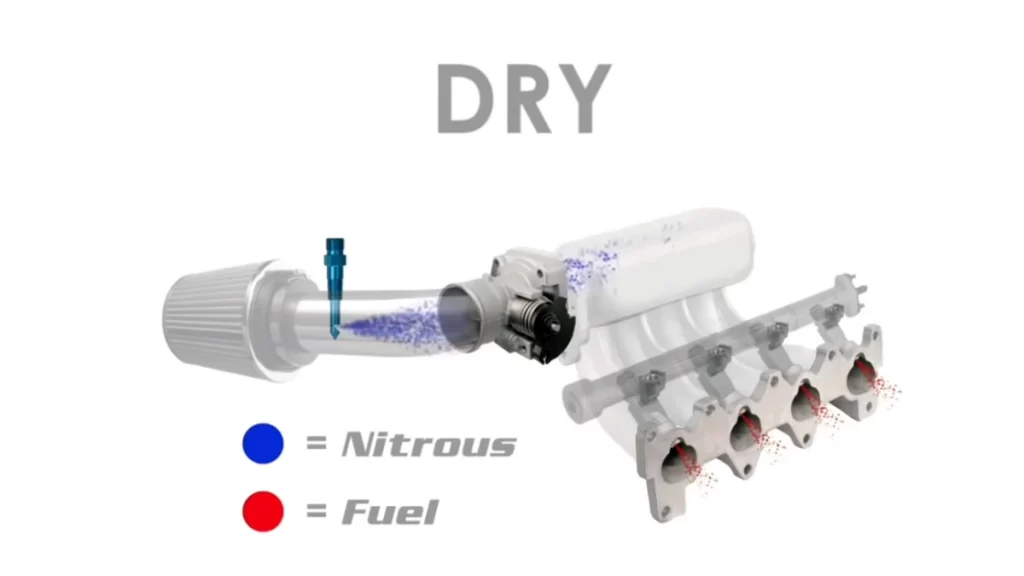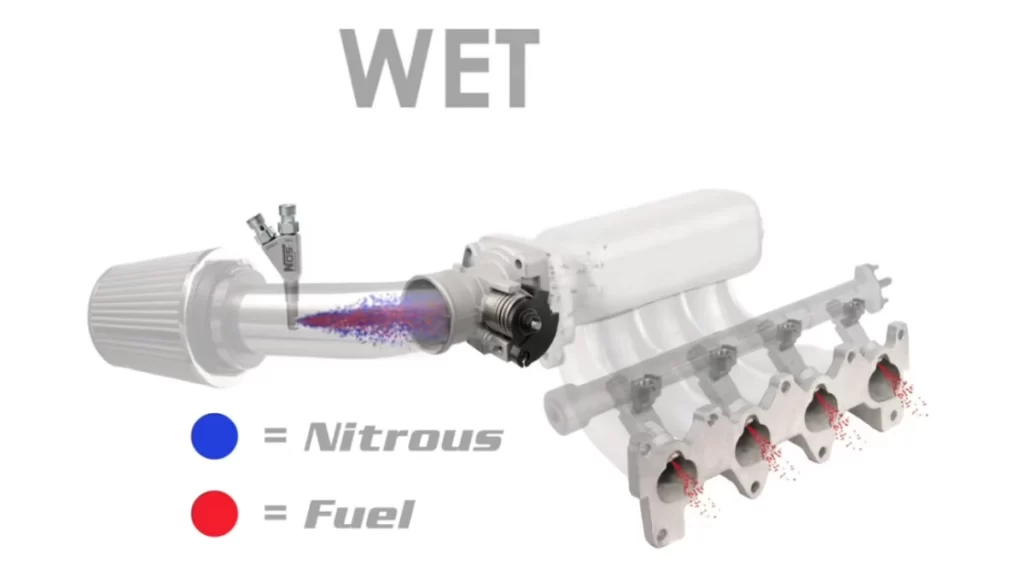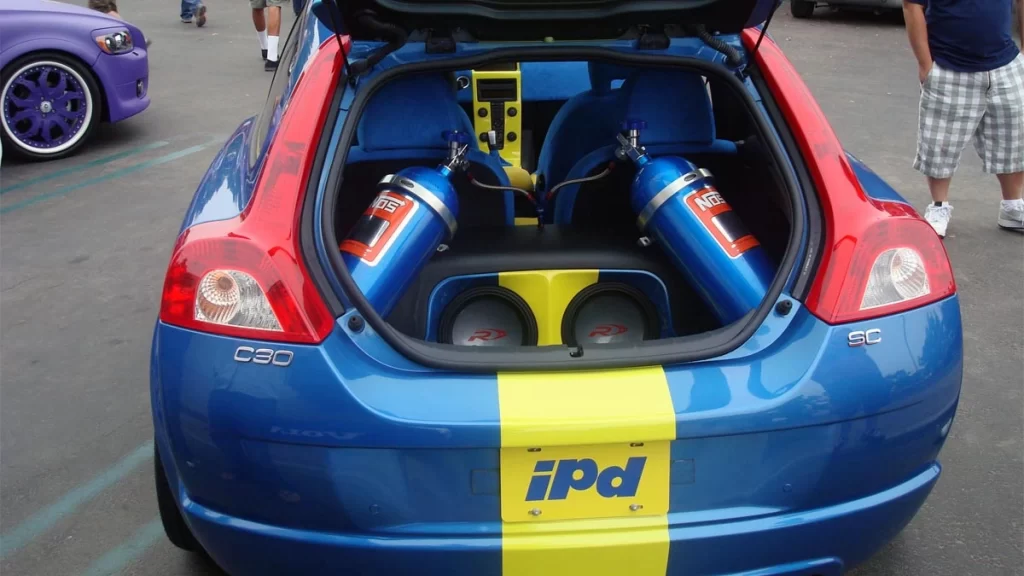Have you ever seen film scenes where the race car drivers push a button and sprint to the end line in no time? I am pretty sure you have noticed that same scene in several films and TV series. Also, I’m sure you have heard the word “Nitrous” in such scenes. So that is what we are going to discuss in this article. So, What Does NOS Stand for in Cars? The term NOS is usually used for Nitrogen Oxide [N2O], which is used to increase the engine’s horsepower in no time for better performance.
In this technique, Nitrogen Dioxide is injected into the combustion to provide more O2 concentration to make the fuel combustion more effective, which gives out a lot of increased horsepower.
What is the mechanism involved in NOS?
When nitrous oxide decomposes, it produces half a mole of O2 (oxygen gas) and one mole of N2 molecules (nitrogen gas). This breakdown process enables a 36.36 percent oxygen concentration to be attained. Nitrogen gas is incombustible and has no combustible properties.
Air, which contains just 21% oxygen and the remainder nitrogen and other similarly non-combustible and non-combustion-supporting gases, allows for a maximum oxygen level that is 12% lower than that of nitrous oxide.
This oxygen is necessary for combustion; it reacts with fuels such as,
- Gasoline
- Alcohol
- Diesel fuel
- Propane,
Or compressed natural gas (CNG) to produce carbon dioxide, water vapor, and heat, which causes the first two combustion products to expand and exert pressure on the pistons, propelling the engine.
How do the NOS systems do makes power?
When two nitrogen atoms and one oxygen atom come together to form nitrous oxide, the compound is known as N2O. When heated to 570°F (300°C), the nitrogen and oxygen separate. Because of this, combustion will be more efficient if you heat this in an engine.
“More oxygen accessible equals more fuel needed to maintain the air-to-fuel ratio ideal, which results in a more powerful explosion and hence more torque sent to the wheels and quicker acceleration.”
What Does NOS Stand for in Cars? NOS system types.
Dry NOS system.
Nitrous is delivered only via the nitrous delivery technique in a dry nitrous system. The additional gasoline is injected through the fuel injectors, which keeps the manifold clear of fuel. This feature is the basis for the dry system’s moniker. Increased fuel flow may be accomplished by raising either the pressure or the duration of the fuel injectors.

Wet NOS system.
In a wet nitrous system, the Nitrous and gasoline are delivered concurrently, resulting in the intake manifold being “wet” with fuel, hence the category’s name. Wet nitrous systems are compatible with all four primary modes of delivery.

Single nozzle NOS system.
A single nozzle nitrous system injects Nitrous or a blend of gasoline and Nitrous via a single injection point. In fuel-injected applications, the nozzle is usually installed after the air filter, before the intake manifold and throttle body, and after the throttle body in carbureted applications.
Plate NOS system.
A plate nitrous system utilizes a spacer between the throttle body and intake ports that has holes drilled along its inside surfaces or in a tube hanging from the plate to transfer the Nitrous or fuel/nitrous combination.
Bar NOS system.
A bar nitrous system delivers Nitrous through a hollow tube with several holes punched along its length that is put into the intake plenum. Due to the bar’s inefficient fuel distribution capabilities, bar nitrous delivery techniques are virtually solely dry nitrous systems.
Why do the NOS systems pretty dangerous?
In reality, NOS systems are not quite dangerous when it is built with the best technology. There is a risk of leaking or an explosion when the system is not made with safety. But apart from that risk, there is plenty of trouble for the passengers and the other vehicle if the NOS systems are used on the roads.
Due to the injection of Nitrogen Oxide, the engine can speed up to an uncontrollable rage. So when the driver does not have pretty good control over the vehicle during NOS injections, that vehicle poses a significant risk to other cars on the road.
Whether tuning technique is utilized, the danger of engine component failure is the same whether it is done with a properly constructed nitrous system or not (on a healthy engine). When compared to alternative tuning methods, employing nitrous oxide allows you to lessen stress on critical engine components while improving vehicle performance at the same time.
What Does NOS Stand for in Cars? The legal side.
There are certain nations where nitrous oxide injection systems for vehicles are outlawed. Nitrous oxide injection systems are prohibited in New South Wales, Australia, according to the Roads & Traffic Authority Code of Practice for Light Vehicle Modifications, which has been in effect since 1994.
Using N2O is permitted in Great Britain, but it must be notified to your car insurance provider, which might result in a higher premium or refusal to insure your vehicle.

A nitrous system may be installed in a street-legal vehicle in Germany, despite the rigorous TÜV regulations. As with aftermarket natural gas conversions, the system must meet specific technical standards.
FAQs related to the “What Does NOS Stand for in Cars?”.
Is turbo better than Nitrous?
Adding a turbo to a high-performance drag vehicle that uses staged nitrous oxide induction is unlikely to make much difference. A turbocharger works well as long as the vehicle’s wheels, driveshaft, tires, and engine have enough control over their respective power outputs.
What are whippets?
To describe the inhalation of nitrous oxide, “whippets” (also written “whippits” or “whip-its”) has been coined as a modern slang term. The term is derived from the cracking open of whipped-cream aerosol canisters to access the gas inside.
Does NOS save your fuel?
In the end, Nitrous does not significantly impact fuel economy. It does consume extra gasoline when you use it, but that’s only when you use it. Turbos are also helpful in producing a lot of power without having a detrimental impact on the fuel efficiency of day-to-day driving.
On the other hand, Nitrous is only activated when the engine is being used to its full potential. On the other hand, Turbos require more gasoline every time the accelerator is down all the way. The nitrogen benefit outweighs the trade-off for most individuals.
We hope you found the answer to your question, ” What Does NOS Stand for in Cars ” after reading our explanation. If you have any further questions, please post them in the comments section below, and we would be happy to assist you. If you’re looking for answers about What VIN Numbers, click to this site. Thank you very much.
